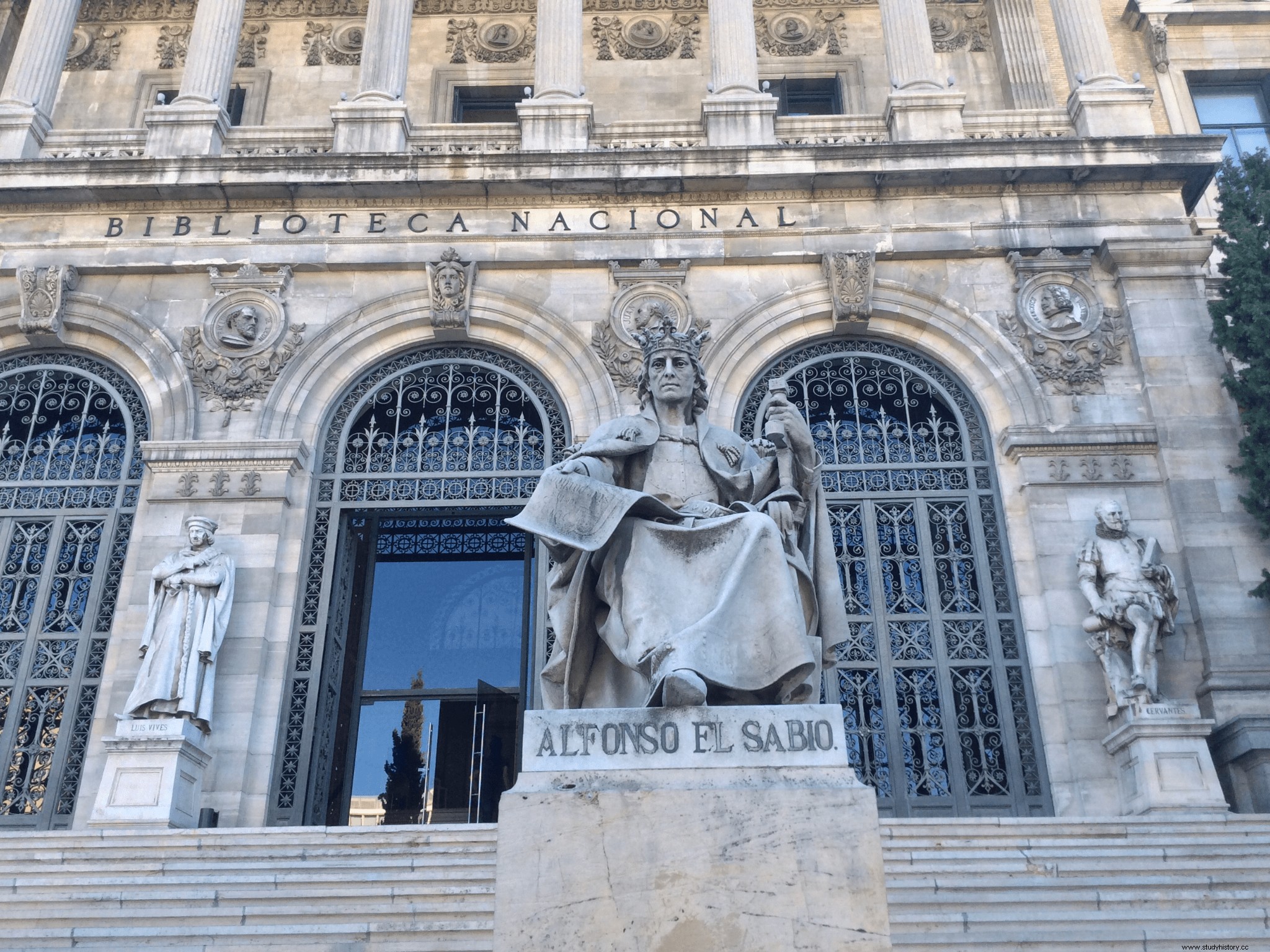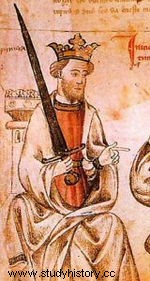The name of the de la Cerda family frequently resonated in accounts of the struggle for power in late medieval Castile and continued to play a prominent role in Spanish politics well into the Modern Age; The famous princess of Éboli was called Ana de Mendoza de la Cerda y de Silva y Álvarez de Toledo.
The origin of this powerful Castilian family can be found in the reign of Alfonso X el Sabio. A monarch who unsuccessfully pursued the dream of being crowned Holy Roman Emperor. His mother Beatrix of Swabia was a granddaughter of the great Frederick I Barbarossa and a cousin of Frederick II, known as Stupor Mundi (the link is to the article about him on the appreciable Tempus Fugit page, which he has kindly allowed me to use). After his failed imperial adventure, Alfonso X had to face a complex succession situation in Castile in the last years of his reign.
From his marriage with Violante de Aragón up to eleven children were born, six women and five men. For the purposes that interest us here, his first two sons were Fernando de la Cerda, born in 1255, and Sancho, born in 1258, who would be king of Castile and León with the name of Sancho IV el Bravo.
I have always been fascinated by that name «De la Cerda» with which the infante Fernando was known and after him his descendants. According to the Blasones Hispanos page, the infant Fernando was born with a lock of hair (cerda ) on the chest, and this was the reason why the nickname of infante de la sow was applied to him. Later his descendants adopted this nickname as a family surname. Be that as it may, Fernando was the heir to his father Alfonso X as the first male child.

However, 1275 would become an annus horribilis for the Castilian monarch. In the spring of that year he traveled to Beaucaire, where Pope Gregory X definitively closed the doors to the long-awaited imperial throne that he had been pursuing for almost twenty years. But the worst was yet to come when, shortly after returning from that trip, he received the news of the death of his heir, the infante Fernando de la Cerda, which occurred in Ciudad Real in November of that year. He is buried in the Burgos Monastery of Las Huelgas (the image that heads the entry belongs to his tomb).
In addition to the logical pain for the loss of a son, the Castilian monarch must have been overwhelmed by the succession complexities that the death of Fernando meant for the kingdom. Despite being only twenty years old, the infante had two children, Alfonso and Fernando, born from his union with Blanca, sister of Philip III of France. This meant that the two boys, who quickly became known as the infantes de la Cerda, had powerful supporters due to their ties to the royal families of Aragon (because of their grandmother Violante) and French (because of their mother Blanca).
The inheritance problem that was approaching in Castile was partly attributable to Alfonso X himself. In the ambitious legal code that he had drawn up, the famous Partidas , had established that in the succession to the throne it should be the sons of the first-born of the crown who succeeded him in his rights. However, the second son of Alfonso X, Sancho, was of a very different opinion. For him, the Castilian tradition established that if the eldest son of a king died during his lifetime, the hereditary rights passed to the next son of the monarch, in this case to Sancho himself.

To further aggravate the situation, the two more great and powerful families of the Castilian nobility, the Lara and the Haro each took a different side; the Laras favored the infantes de la Cerda (the infante Fernando had appointed Juan Núñez de Lara as his sons' tutor on his deathbed), while the Haros (headed by Lope Díaz de Haro, lord of Vizcaya) They decided to support the instant Sancho.
At the Cortes held in Segovia in 1278 Alfonso recognized Sancho as heir, but this provoked the indignation of his wife Violante, sister of Pedro III of Aragón, who fled to court of his brother along with his grandchildren the infantes de la Cerda and their mother, Blanca de Francia. Violante would soon return to Castile, but the infantrymen remained in Aragon. From there they received the support of their uncle Philip III of France, who threatened to invade Castile. Alfonso X tried to avoid this dangerous situation by negotiating with the French the delivery to Alfonso de la Cerda of the kingdom of Jaén, provided that he recognized himself as a vassal of Sancho.
All these compromises had the frontal opposition of Sancho, which broke out in the Cortes held in Seville in 1281. Sancho became the head of the nobles dissatisfied with the government of Alfonso that, protected by the Departures , had reinforced royal authority through legal and fiscal measures. Thus, it was not difficult for Sancho to find many supporters among the nobility for his cause.
The situation worsened when Sancho called a meeting in Valladolid in 1282 with the purpose of dethroning his father. He had the presence and support of his brothers, the Haro family and other powerful families of the Castilian nobility and clergy (" together all those of the land and all the rich omnes who walked outside »). At the proposal of the king's own brother, the infante Don Manuel, it was approved to hand over to Sancho the government, fortresses and revenues of the kingdom, as well as the administration of justice, but they agreed that Sancho would not take the title of king during his father's lifetime. .
Alfonso reacted by disinheriting Sancho in November 1282 and granting a will in November 1283 in which he decreed that the throne would pass to the infantes de la Cerda, Alfonso first and, after him, his brother Fernando. He even went so far as to establish that if they both died without issue, he would inherit the kingdom Philip III of France (as the grandson of Blanca de Castilla, queen of France and daughter of Alfonso VIII).
Alfonso X el Sabio died in Seville on April 4, 1284. His will was not respected and his son Sancho was recognized and crowned king of Castile in Toledo. The reign of Sancho IV el Bravo began. The infants of La Cerda did not resign themselves to this situation... but that is another story.
Image| Sepulcher of the infante Fernando and portrait of Sancho IV:Wikimedia commons. Statue of Alfonso X:author's archive.
José Fontana and Ramón Villares (Directors). History of Spain. Eduardo Manzano Moreno . Medieval times. Volume II.
Vicente Ángel Álvarez Palenzuela (Coordinator). History of Spain in the Middle Ages.
